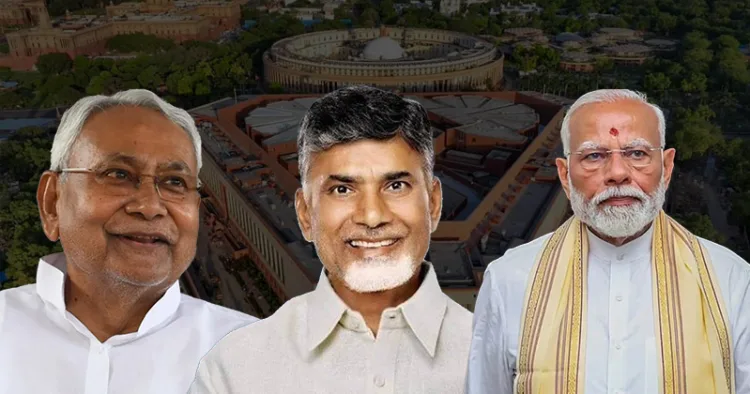On June 4, Bharat marked a historic day by successfully concluding one of the world’s largest elections. The results were a mix of fulfilment for some and disappointment for others. The Bharatiya Janata Party (BJP) emerged as the largest party with 240 seats, while the Congress secured the position of the second-largest party with 99 seats, taking the I.N.D.I. Alliance seat tally to 234.
After the final votes were tallied, the results are as follows: the NDA, comprising the BJP, JD(U), TDP, and other allies, has secured 292 seats, surpassing the 272 seats required to form the government.
Of the 292 seats won by the NDA, the BJP claimed 240 seats, Nitish Kumar’s JD(U) won 12 seats, and Chandrababu Naidu’s TDP secured 16 seats. Together, these two allies contribute 28 seats to the NDA’s total.
On the other hand, the INDI Alliance, which includes the Congress, Trinamool Congress (TMC), Aam Aadmi Party (AAP), Samajwadi Party (SP), and others, obtained a total of 234 seats.
Within the INDI Alliance, the Congress secured 99 seats, the Akhilesh Yadav-led SP won 37 seats, and the TMC claimed 29 seats.
Political pundits suggested that the power to secure a majority now lies in the hands of these allies, and a switch to the I.N.D.I. Alliance could disrupt the BJP’s plans.
There are claims that the BJP may struggle to make the ‘Big Decisions’ they had planned before the elections. Experts believe the current coalition dynamics may force the BJP to shift its primary agendas to the back burner.
However, the speculation that the TDP and JD(U) might switch allegiance to the I.N.D.I. Alliance is seen as an unrealistic narrative that doesn’t align with the current political landscape.
Firstly, individually, their switching sides does not threaten the BJP government’s majority. Neither the TDP nor the JD(U) would move unless both are solidly committed to the switch.
Secondly, even if the JD(U) and TDP with their 28 seats switched sides, the INDI Alliance tally would go up to 262, requiring the Opposition to reach out to other parties to reach the majority mark of 272, preventing them from forming the government.
Moreover, LJP’s Chirag Paswan in Bihar and Jan Sena’s Pawan Kalyan are staunch supporters of the BJP leadership and have unequivocally stated their loyalty to the NDA. This strong support sets a precedent for other NDA partners like the JD(U) in Bihar and the TDP in Andhra Pradesh.
Specifically, the TDP would not want to antagonise Jan Sena, as the Kappu community’s votes, which Jan Sena commands, backed the TDP in this election. Their desertion in 2019 was a significant factor in the TDP’s humiliating defeat.
Similarly, Nitish Kumar has little incentive to switch sides. Any political ambitions he may have can be accommodated within the current arrangement, and Congress does not offer much in terms of incentives.
Regarding the speculation about Naidu handing over the CM post to his son and moving to the centre for a bigger role, it is important to understand that regional leaders do not leave state politics when faced with formidable rivals like the YSRC. Naidu can easily negotiate for key ministries from the BJP while continuing as CM. Given his track record from the mid-1990s to 2004 and from 2014 to 2019, Naidu and Modi share similar views on economic and fiscal policies.
Thus, there is no significant draw for Naidu to leave, as Modi’s current focus on socialist measures does not clash with their shared policy interests. For Naidu, the development of Amaravati as the state capital is a top priority, which requires land and labour reforms—issues that the BJP is likely to support at the national level.
A special package for Andhra Pradesh could also serve as a model, with Nitish potentially seeking similar benefits for Bihar.
Both Nitish and Naidu have significant limitations: they cannot lead the formation of an opposition government, nor can they bring along other NDA allies like Jan Sena and LJP. Therefore, there is no substantial basis for the speculation that Naidu and Nitish might switch sides against the BJP-led government.
Narendra Modi is poised to become the first incumbent prime minister to secure a third consecutive term since Jawaharlal Nehru did so in 1962. In 2019, Modi became the first prime minister to win re-election with a majority since Indira Gandhi’s achievement 48 years earlier.
Highlighting the numerous significant decisions taken by the BJP for the nation’s benefit, Prime Minister Narendra Modi stated on June 4, that the BJP-led National Democratic Alliance (NDA) government will embark on a new chapter of decisive governance in its third term.
Addressing the public at the BJP headquarters in the national capital as the counting of Lok Sabha election votes neared completion, Modi declared, “If you work 10 hours, Modi will work 18 hours. If you take 2 steps, Modi will take 4 steps. We Indians will walk together and move the country forward. The country will write a new chapter on making big decisions in the third term. And this is the ‘Modi Ki Guarantee’.”



















Comments